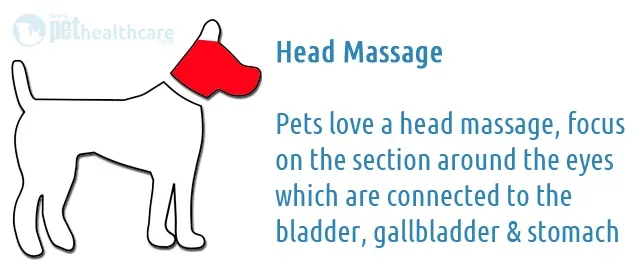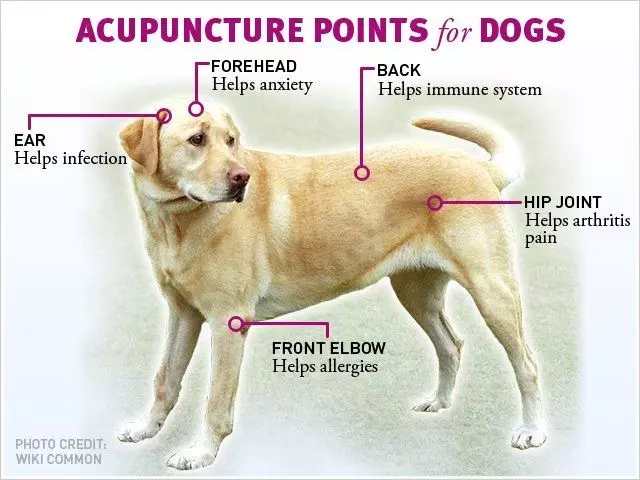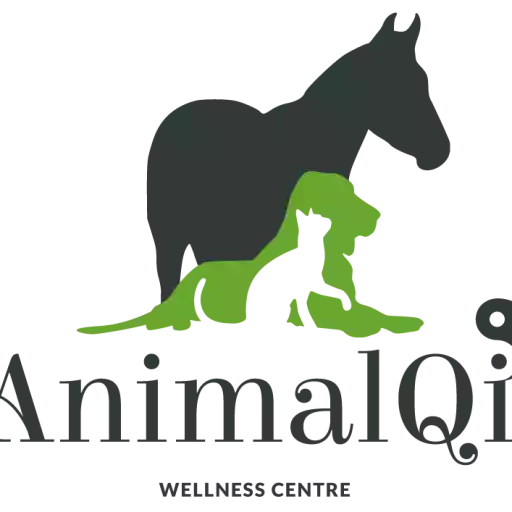Information
Small Animal Tui-na Techniques for Home Care

Tui-na is a manual therapy that is one of the five brances of traditional Chinese veterinary medicine (TCVM) and uses Chinese medical theory as the basis for its application and actions. It was first used in the 16th-11th centuries BC and references to this treatment can be found in the Huang Di Nei Jing (Yellow Emperors Inner Classics 475-221 BC).
From a conventional medicine perspective, Tui-na can be thought of as corresponding to a combination of acupressure, conventional massage and chiropractic techniques.
It can be used to regulate the Channels, soothe joints and sinews, promote circulation of Qi and Blood, strengthen the immune system and promote normal function of the Zang-fu organs.
Tui-na is most used to treat acute and chronic musculoskeletal conditions and is also useful as a preventative medicine therapy because it promotes balance in the body. Small and large animals and exotic species respond well to Tui-na treatments and it can be used for animals that will not allow acupuncture needles to be placed. It is safe and effective with no known side effects. Although veterinarians must receive specific training in the techniques and applications of Tui-na, once mastered several Tui-na techniques can be easily taught to caretakers for home treatment.
Mo-fa (touching skin and muscle), Rou-fa (rotary kneading), Ca-fa (rubbing), Tui-fa (pushing), An-fa (pressing), Nie-fa (pinching), Dou-fa (shaking), Ba-sheng-fa (stretching) and Cuo-fa (kneading) are Tui-na techniques that caretakers can learn and use to accelerate the healing process and deepen the connection with their animals.


Tui-na has clinically been observed to help promote and regulate normal circulation of Qi and blood through the Channels of the body and restore balance (restores Yin-Yang balance). Tui-na can be used to promote normal functioning of the internal organs (balance Zang Fu organs) and improve immune function (strenghten body resistance). In other sections Tui-na techniques were recorded as being successful in the treatment of various disorders, including joint pain (Bi syndrome), muscle weakness and atropy (Wei syndrone), facial paralysis and stomach pain. Other chapters of the Huang Di Nei Jing describe the therapeutic effects of Tui-na that include resolving pain, moving Qi, invigorating Blood, eliminating Pethogens and dispersing Heat (having the ability to relieve fever) in specific cases.
In traditional Chinese veterinary medicine (TCVM) Tui-na is most used for the treatment of acute and chronic conditions of the musculoskeletal system. Tui-na treatments can be useful to align and restore the normal anatomic relationships of the bones, muscles, tendons and ligaments of the body (soothe tendons and ligaments) in these conditions. Tui-na can also be useful to treat problems of the digestive and respiratory systems and is well suited to notification and strengthening weak, chronically ill, geriatric and paediatric animals. Small and large animals as well as exotic species can be treated with Tui-na, which is especially useful for the treatment of fractious animals that will not allow acupuncture. Many TCVM practitioners combine Tui-na with acupuncture, Chinese herbal medicine, Food Therapy and an exercise/lifestyle programs for an enhanced therapeutic effect. Tui-na is a safe and effective therapy with no known side effects and is contraindicated in pregnant animals, open wounds, skin injuries, dermatitis, fractures, phlebitis and infectious diseases with zoonotic and or iatrogenic transmission potential.
Tui-na Techniques
Mo-fa (touching skin and muscle): Mo-fa is performed by rubbing the skin in a spiral, rhythmic motion using the palms of the hands and fingers with light to moderate pressure. This technique is thought to use nervous system reflexes to exert an effect through the skin and superficial connective tissues to restore order to the circulation and may promote homeostatic reactions in internal organs. Mo-Fa is often used as a general introductory technique for Tui-na to acclimate animals for other techniques and is especially useful for weak and geriatric animals. It is used to regulate Qi, harmonize the Middle Burner (Zhong Jiao), drain Stagnation and remove accumulations and can be used to treat constipation, diarrhea and food retention.
Rou-fa (rotary kneading): Rou-Fa is performed with a gentle rotational motion using the ball of the fingers and the heel of the hand. This is one of the most common Tui-na methods and is used to regulate the actions of the other techniques. It functions to harmonize the Ying and Wei, resolve Qi and Blood Stagnation, relieve pain and eliminate food retention. Rou-Fa is especially good for Deficient animals and is often used as an introductory technique at various acupoints and Ah-shi points all over the body, before using techniques that work on deeper tissues. It is commonly combined with An-fa to produce a combination technique Rou-An-Fa
Ca-fa (rubbing): Ca-fa is performed by applying rapid, linear and moderately forceful movements of the palms, while firmly touching the skin. This technique produces softly warming stimulation to the skin and underlying tissues. It warms the Channels and Collaterals. It is extremely useful for Yang Deficient geriatric animals that feel cold to the touch and for Qi
Stagnation and Cold Patterns with abdominal and lumbar pain. It is extremely useful to treat chronic renal failure with Yang Deficiency and in animals with poor peripheral circulation it can be combined with Cuo-fa discussed below.
Tui-fa (pushing): Tui-fa is performed in a forceful one-directional movement using the finger, thumb, palm or elbow that follow the lines of major muscles, tendons and ligaments. It can be performed using the index fingers and/or thumb bilaterally along the epaxial muscle groups of the spine from T10-L7 in a smooth gliding motion along these tissues especially useful in animals with intervertebral disk disease (IVDD). Initially light pushing should be used with progressively deeper pressure as the tissues and the animal allow. Tui-fa can be alternated with An-fa described below. This technique is used to relax the tendons and invigorate Blood and Qi flow. It is one of the more common techniques to treat the vertebral 3 column and limbs for Bi syndrome, IVDD and spondylosis and is one of the most important techniques to soften the connective tissues. It can also be used to dissipate nodules and masses. Tui-fa is like myofascial release techniques practiced in other conventional body-work techniques.
An-fa (pressing): An-fa is applying light pressure to an area using the thumb and or index finger with deeper pressure gradually applied. This technique is often performed with or following Rou-fa (discussed above). This single finger pressing technique is used to relieve Qi and Blood Stagnation and unblock obstruction.
Ba-sheng-fa (stretching): The caretaker is asked to pull and apply gentle traction to the muscles and joints of the limbs. Traction on the tail can also be applied as part of this treatment for 10 repetitions each time. The owner should strive to perform this technique rhythmically for best results. Ba-Sheng-Fa is used to regulate the Channels, mobilize and restore the normal anatomic position of the joints, tendons and ligaments of the pelvic limbs.
Dou-fa (shaking): During Dou-fa each limb is continuously shaken or vibrated gently with an up-down motion using both hands, while fully supporting the limb. This technique is used to regulate the Qi and Blood and smooths the joints.
Cuo-fa (kneading): Cuo-fa is usually performed on each limb using rapid kneading movements with the palms of both hands, moving back and forth and up and down the limb. The force should be equal in both hands and kneading should be rapid, but the movement up and down the limb should be slow. This technique can also be used on the neck, chest, hypochondriac region, abdomen and waist. This technique regulates the Channels and moves Qi and Blood. Cuo-fa is typically used at the end of a Tui-na treatment.
Nie-fa (pinching): Nie-fa is performed by pinching and squeezing the skin and epaxial muscles of the vertebral column with the fingers. This technique is useful to invigorate the Blood and Qi and regulate the Spleen and Stomach and is especially important to help stimulate appetite. Nie-fa is commonly used to regulate the vertebral column.
Tui-na Tips
- Emphasize that all treatments are to begin softly and slowly. Too much force is to be avoided and treatments should be done with even pressure.
- Caution should be used in performing Tui-na on geriatric, weak and debilitated animals that could become further weakened by treatments that are too vigorous or lengthy in duration. Tui-na treatments can last 10 minutes to 1 hour.
- Do not give owners too many techniques to do at one time; in the author’s experience; prescribing only 3-4 different Tui-na techniques (no more than 30-45 minutes) are met with the best compliance by the average caretaker.
- Give caretakers a Tui-na work sheet and write down all techniques to be performed and the duration of each; have the owner keep a log of treatments and review it during recheck examinations.
- Demonstrate to caretakers each Tui-na technique to be done; then have them show you how they will do it at home.


- It is recommended that treatment be performed every day to ensure that treatments are done at least 3-5 times per week. ul-na once daily is ideal.
- It is beneficial to have the caretaker return in 1 week and demonstrate to the veterinarian the assianed Tui-na techniques on their pet.
- Tui-na treatments should be performed before acupuncture needles are placed; it is more effective to massage the area before and after acupuncture for best results.
- Tui-na techniques may also be supplemented with oral Chinese herbal medicine and herbal liniments, salves, sprays and patches as needed.
- It is best to wait 30 minutes following a meal before performing a Tui-na treatment to allow normal blood flow to the bowel for proper digestion.
REFERENCES 1.www.acupuncture.com/qigong_tuina/tuinahistory.htm 2. Ni MS. The Yellow Emperors Classic of Medicine. Boston, Massachusetts: Shambala Publications 1995:42-223. 3. Xie H, Ferguson B, Deng X Annlication of Tui-na in Veterinar Medicine Reddick FI Chi Institute. 2008 1-206 *Renrinted with Dermission from Xie H Ferauson B Dena X Annlication of Tui-na in Veterinarv Medicine 2nd Reddick FI-Ch Institute 2008:7. Signe Beebe DM Integrative Veterinary Center, Sacramento CA 4. Google images


